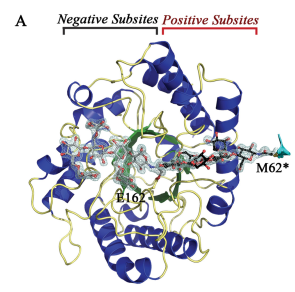By Namrata Jain, GreenChem UBC (Invited post!)
Biofuels, in particular bioethanol, are widely accepted as carbon-neutral fuels1, meaning they have no net greenhouse gas emissions; the amount of carbon dioxide produced during their combustion equals the amount fixed from the atmosphere while the plants grow. These fuels provide an alternative to the current outrageous usage rate of fossil fuels. Plant biomass, a renewable and abundantly available natural resource, is used as the main source for bioethanol production.
In order to produce bioethanol, polymeric plant carbohydrates (polysaccharides) must be broken down into the corresponding monosaccharides, followed by fermentation via yeasts. Typically, starch-rich crops such as corn and sugarcane are the most heavily used as carbohydrate sources.
However, since utilization of these starchy sugars in bioethanol production competes with their use as food crops, there has been a recent shift towards utilization of lignocellulosic biomass.1 Lignocellulosic biomass includes cellulose and hemicelluloses present in non-edible parts of plants, and hence reduces dependence on edible, starch-rich crops.

Figure 1. Structure of a plant cell wall, highlighting xyloglucan, a particular hemicellulose of interest. [2]
The complete utilization of this biomass, however, is hindered by the structural complexity of plant cell walls, arising from the heavy crosslinking between hemicelluloses, celluloses, and lignin within, making it difficult to access the degradable polysaccharidic components. Hemicelluloses, such as xyloglucan (Figure 2A), can make up 15-50 % of these lignocellulosic materials and have been the focus of research for optimization to use as a biofuel.
To efficiently break down the lignocelluloses, many types of enzymes are needed. Glycoside hydrolases, one such group of carbohydrate active enzymes, have proven to be very efficient in the hydrolysis of many complex polysaccharides.3 However, more details about the chemical structure of the enzymes, as well as a reliable way of comparing the kinetic activity of various enzymes has been of interest to researchers in the field.
One of the ways of quantifying the kinetic details of such enzymes is by designing chemical probes such as one shown in Figure 2B. Such probes are chemically very similar in structure to the polysaccharide of interest (eg. Figure 2A), and hence can subtly fit into the active site of the enzyme and manipulate its rate of catalysis in a controlled and quantifiable way, making comparisons between enzymes’ kinetics possible.

Figure 2. Structures of (A) xyloglucan; and (B) xyloglucan oligosaccharide based probe.
These probes can also assist in the crystal structure formation of the enzyme providing key details about the nature of interactions between the enzyme and corresponding polysaccharide and the specific amino acids responsible for its catalytic activities (Figure 3).
The Brumer group at the University of British Columbia4 has recently designed one such probe (Figure 2B) specific for xyloglucan active enzymes (xyloglucanases) by chemically modifying a xyloglucan-derived heptasaccharide. This probe was able to provide valuable information about the kinetics, specificity, as well as structural details of a newly discovered xyloglucanase PbGH5, which is secreted by a microbe residing in the intestinal system of ruminants such as cows.

Figure 3. Crystal structure of the characterised endoxyloglucanase in complex with the inhibitor. [4]
References:
- Scheffran J. The Global Demand for Biofuels: Technologies, Markets and Policies. In: Biomass to Biofuels: Strategies for Global Industries. Blackwell Publishing Ltd.; 2010:27-54. doi:10.1002/9780470750025.ch2.
- https://en.wikipedia.org/wiki/Cell_wall#Plant_cell_walls
- Henrissat B, Davies G. Structural and sequence-based classification of glycoside hydrolases. Curr Opin Struct Biol. 1997;7(5):637-644. doi:http://dx.doi.org/10.1016/S0959-440X(97)80072-3.
- McGregor N, Morar M, Fenger TH, et al. Structure-function analysis of a mixed-linkage β-glucanase/xyloglucanase from key ruminal Bacteroidetes Prevotella bryantii B14. J Biol Chem. 2015;291(3):1175-1197. doi:10.1074/jbc.M115.691659.

